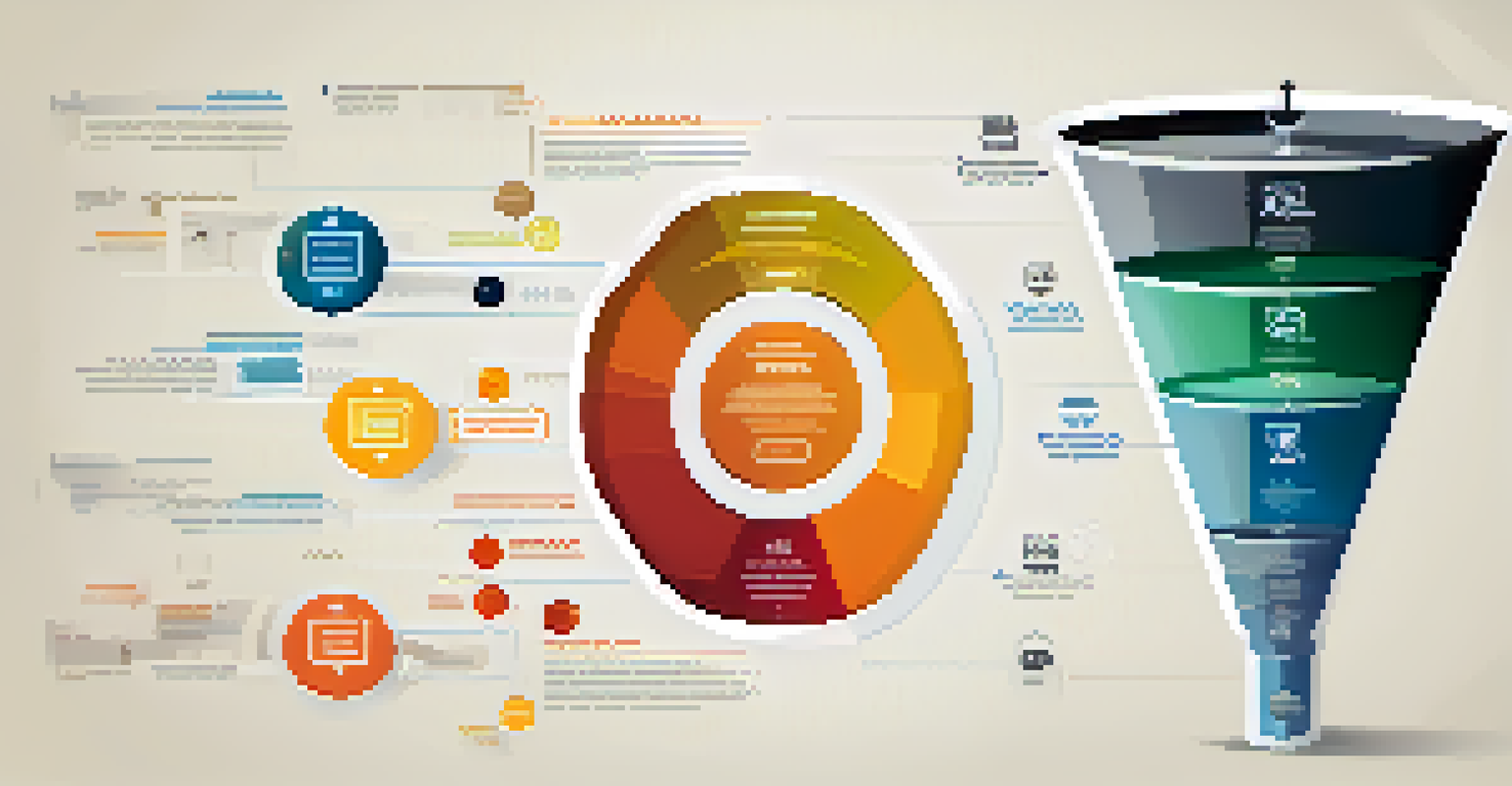Using Analytics to Enhance Sales Funnel Performance

Understanding the Sales Funnel: A Quick Overview
The sales funnel is a model that illustrates the journey potential customers take from awareness to purchase. Think of it like a funnel that narrows down leads as they progress through different stages. Each stage—awareness, consideration, and decision—requires specific strategies to guide prospects effectively.
Without data, you're just another person with an opinion.
By understanding this model, businesses can tailor their marketing efforts to meet the needs of their audience at each stage. For instance, informative blog posts can attract attention in the awareness phase, while compelling case studies can sway decisions in the consideration phase. This targeted approach is essential for maximizing conversions.
Analytics plays a crucial role in dissecting the sales funnel. By examining data, businesses can identify where potential customers drop off and what factors contribute to their decisions. This insight helps refine strategies and improve overall funnel performance, leading to higher conversion rates.
The Role of Data in Understanding Customer Behavior
Data analytics allows businesses to gain deep insights into customer behavior, preferences, and pain points. By tracking user interactions on your website or app, you can see which content resonates most with your audience. This information can be invaluable for shaping your messaging and offerings.

For example, if analytics show that users frequently visit a particular product page but leave without purchasing, it may indicate a need for more persuasive content or better pricing. Addressing these issues can significantly enhance the likelihood of conversion. Understanding customer behavior helps you not only attract leads but also engage and nurture them effectively.
Sales Funnel Guides Customer Journey
The sales funnel model outlines the stages potential customers go through, enabling businesses to tailor their marketing strategies effectively.
Moreover, analyzing customer feedback and reviews can reveal valuable insights. It’s not just about numbers; qualitative data can highlight areas needing improvement. By blending quantitative and qualitative analytics, businesses can create a more holistic view of customer behavior that drives sales funnel optimization.
Identifying Bottlenecks in the Sales Funnel
Bottlenecks in the sales funnel often occur when potential customers lose interest or face obstacles that prevent them from progressing. Utilizing analytics tools, businesses can pinpoint these critical areas where leads drop off. This might be during a particular stage, like the checkout process or while filling out a contact form.
The goal is to turn data into information, and information into insight.
For instance, if data reveals a high abandonment rate on your checkout page, it’s a clear sign that something needs to change. Perhaps the process is too complicated, or unexpected costs are discouraging purchases. Addressing these bottlenecks not only improves user experience but can also lead to significant increases in sales.
Once you've identified these issues, the next step is to implement changes and monitor the results. A/B testing different approaches can help determine what works best. By continuously refining the funnel based on analytics, businesses can create a smoother path to conversion.
Using Analytics to Enhance Lead Qualification
Lead qualification is essential for ensuring that your sales team focuses on the most promising prospects. Analytics can help evaluate leads based on their behavior and engagement levels. By analyzing how leads interact with your content, you can gauge their interest and readiness to buy.
For example, if a lead repeatedly downloads resources or engages with email campaigns, it’s a strong indicator of interest. Conversely, leads that only visit your site once may be less likely to convert. By prioritizing leads based on analytics, your sales team can invest their time and resources more effectively.
Data Drives Customer Insights
Utilizing analytics helps businesses understand customer behavior, allowing for more targeted messaging and improved conversion rates.
Moreover, implementing scoring systems based on analytics can streamline this process. Assigning points for specific actions, like attending webinars or requesting demos, helps create a clear picture of lead quality. This not only improves efficiency but also enhances the likelihood of successful conversions.
Personalization: Tailoring Experiences with Data
Personalization has become a key factor in driving sales and improving customer satisfaction. By leveraging analytics, businesses can create tailored experiences that resonate with individual consumers. This might involve personalized email marketing, customized product recommendations, or targeted ads based on previous interactions.
For instance, if analytics reveal that a customer frequently browses a specific category, sending them personalized offers can enhance engagement. This kind of targeted approach not only increases the chances of conversion but also fosters customer loyalty. People appreciate feeling valued and understood by brands.
Additionally, tracking customer journeys allows businesses to refine their personalization strategies continually. By analyzing data over time, you can identify trends and adjust your tactics to meet evolving customer needs. This dynamic approach to personalization helps ensure that your marketing efforts remain relevant and effective.
Measuring Success: Key Metrics to Track
To effectively use analytics in enhancing sales funnel performance, it's essential to measure success through key metrics. Metrics like conversion rates, customer acquisition costs, and average order value provide valuable insights into how well your funnel is performing. Monitoring these figures helps gauge the effectiveness of your strategies.
For example, if your conversion rate is low, it may indicate issues with your content or user experience. On the other hand, a high average order value could suggest that upselling or cross-selling strategies are working well. By focusing on these metrics, businesses can make informed decisions about where to direct their efforts.
Continuous Improvement is Key
An iterative approach to refining the sales funnel through ongoing data analysis ensures that strategies remain effective and responsive to customer needs.
Regularly reviewing these metrics also allows for quick adjustments. If a particular tactic isn’t yielding results, it's easier to pivot and try new approaches. In the ever-changing landscape of sales and marketing, staying agile and data-driven is crucial for continued success.
Continuous Improvement: The Power of Iteration
Incorporating analytics into your sales funnel is not a one-time effort; it’s an ongoing process of continuous improvement. Businesses must regularly revisit their strategies and be willing to adapt based on the insights gained from data. This iterative approach ensures that your sales funnel remains effective in meeting customer needs.
For instance, after implementing changes based on analytics, it’s essential to monitor the outcomes and refine your tactics accordingly. If a new strategy leads to improved conversion rates, consider what other areas might benefit from similar adjustments. This mindset fosters a culture of innovation and responsiveness within your organization.

Additionally, staying updated on the latest analytics tools and techniques can enhance your ability to optimize the sales funnel. New technologies often provide deeper insights and greater efficiencies. By embracing a philosophy of continuous improvement, businesses can maintain a competitive edge and drive sustainable growth over time.